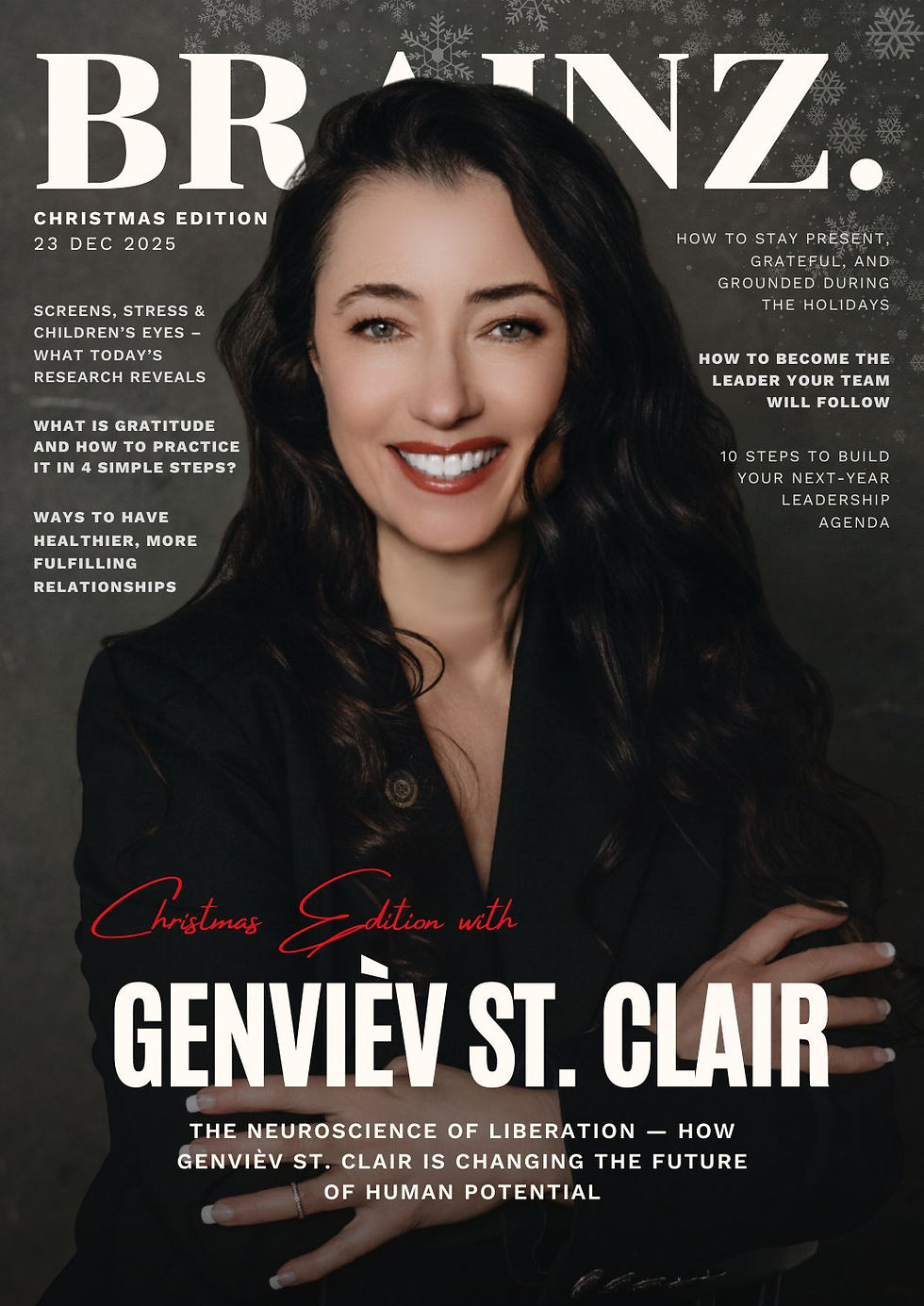How To Create Your Wellness Vision
- Brainz Magazine

- Feb 1, 2024
- 6 min read
Written by: Kelsee Bobrowski, MS, NBC-HWC, Executive Contributor
Executive Contributors at Brainz Magazine are handpicked and invited to contribute because of their knowledge and valuable insight within their area of expertise.

The last article I published, I outlined some various theories and strategies for not failing at your resolutions.

Do you remember these statistics?
Approximately 87% of people are confident they can be successful with their resolutions.
Goals involving body transformation (i.e., improving physical health, increased exercise, more focused nutrition, losing weight) accounted for 74% of resolutions.
Twenty-two percent of individuals reported they were entirely successful by February.
Who is in the 22% population of people who are successful into this month of your resolution(s)? If you find yourself to be wavering in your actions of the resolution(s), there might be another approach that can provide thrust in the new year.
Wellness visions
In the early sessions of health coaching, a wellness vision is established. What is a wellness vision? A wellness vision is a statement that directs goals (4). This statement connects experiences—both positive and negative—core values, and positive change actions to confidently move toward the best version of oneself. You could argue that the wellness vision is the ideal version of oneself while considering the current version of self. The most profound aspect of a wellness vision is that it is ever-changing, ever-evolving as health and wellness progress is made. We begin to identify more strengths, talents, and mindfulness through the wellness journey; it only makes sense our ideal vision would also shift with that growth.
Design your wellness vision statement
Take a moment to complete this exercise as the beginning draft of your wellness vision.
Find a space you feel you can relax. This may involve relocating or reorganizing your current space.
Establish your body in that space. You might be sitting in a chair, standing at a desk, or seated on the floor. Wherever you establish your body, find a position that makes you feel grounded.
Close your eyes.
Follow this breathing pattern: inhale for four seconds, hold at the peak of your inhale for seven seconds, and exhale for eight seconds. (**Do not be discouraged if your breath is asking for less time.) Take notice of the time inhaling, holding, and exhaling that works best for you. Use that pattern for four breaths to get your body in a relaxed state.
Continuing that breathing pattern; notice your body in space. Where is your tension? Where are you rooted to the ground?
Think about this journey you have taken for your health and wellness. What went well? When did you feel the most success? What did not work for you? What obstacles did you encounter during your success or underachievement?
Think about yourself holding a magic wand. You wave that wand and the changes you want to make to be the best version of yourself take shape. What does that look like?
With using “I am” statements, record that ideal version of yourself. Reflect on those strengths, successes, obstacles, and failures that contributed to the current version of yourself. Include those into your wellness vision.
My example:
I am an active woman not caring about age or stigmas with age as I play with my young son.
I am prepared for our adventures because I lift weights four days a week, complete cardio training two days a week, practice yoga two days a week, and practice mindfulness daily.
I am energetic because I do not over-train and under-nourish.
I am nourished by the foods I eat rather than the “get ripped quick” diet fad so that I may have energy for my family.
I am rested because I have learned that access to my phone at night impacts my ability to turn my brain off. A tired wife and momma leads to a more reactive wife and momma.
I am confident as I have learned I love reading books and listening to podcasts and push for continual growth in all dimensions of wellness.
This was not my wellness vision ten years ago. To be honest, this was not my wellness vision two years ago! It has shifted and molded to my experiences and definition of health and wellness. I encourage you to begin developing your vision statement. It may be one sentence; it may be one page. Either way, define your vision for yourself as it establishes long-term motivation and ownership for goals.
Goals
Goals without a vision are just a wish. There needs to be a substance, a purpose that drives our goal development and attainment. We have established our vision, and it is time to reflect on initial goals which move us toward that vision of wellness. Goals come in three forms: performance, learning, and fulfillment (3). Performance goals are those which can be measured objectively. This could be a visceral fat level, number of books read in a year, or one rep max of a deadlift. There is a set metric and objective determination of achievement. Learning goals are those measured through introspection or formal feedback. Some examples of learning goals could be journaling your “golden moment” of the day, self-assessment after listening to a podcast, or an evaluation from another. Fulfillment goals are based on one’s sense or definition of satisfaction. For some, fulfillment goals include self-ratings on a Likert scale (1= not very satisfied; 5= very satisfied). The foundations of a goal are rooted in autonomy; a goal set by others or pushed by others will not be sustainable (3). Think about this for a moment:
You go to work and are told you need to accomplish X, Y, and Z. You work and accomplish told tasks or responsibilities 8-10 hours a day. Then, you have a nutritionist telling you to eat X, Y, and Z because you have a particular weight loss goal. You eat and accomplish told meal plans 3-10 times per week. Then, you have a fitness professional telling you to move X, Y, and Z to meet a particular weight loss goal. You workout and accomplish told fitness programming 3-15 hours per week.
I used the word accomplished, so why do you not feel better about your day? When you do go “off track,” why do you go so far away from that above schedule or plan? Innately, no one likes to be told what to do.
Designing goals for behavioral change
We are back to the conversation about why the resolution set on January 1st is no longer happening February 1st. I would almost bet that you did not read my last article (wink, wink). Goals do not only need to reflect the individual’s vision of wellness and be autonomous; goals need to reflect behavioral change. Behavior change takes a formal plan taking into consideration strengths, obstacles, relevance, and “waypower.” Think about the vision statement—or rough draft of the vision statement—created above. What actions can be taken to move forward? Many people neglect the small actions, but if we have learned anything from Clear’s (2015) Atomic Habits, the small actions which lead to the large actions are critical. There are four rules to build this behavioral change goal:
Make it obvious.
Make it attractive.
Make it easy.
Make it satisfying (2).
Now what?
Now you have your wellness vision and your behavioral change goals (i.e., three “easy wins” is a good starting place), take a new perspective of your 2024 resolution. Working with a health and wellness coach might support you through establishing and achieving your vision. You are welcome to contact me using the information provided or using the National Board for Health and Wellness Coaching directory.

Kelsee Bobrowski, MS, NBC-HWC, Executive Contributor Brainz Magazine
Kelsee Bobrowski is a board certified health and wellness coach with additional advanced certifications in personal training, strength and conditioning, and nutrition. With a background in behavioral science, she has created a business of long-term success for weight loss clientele. She is the owner and sole propietor of Phoenix Fitness, Health, and Wellness, LLC in Boise, Idaho, USA. Kelsee is also a consultant for Alpine Wellness Clinic as the weight loss specialist and adjunct psychology instructor for College of Western Idaho. Her mission is to allow clients to "rise from their ashes" and use their strengths toward their wellness vision.
References:
Discover Happy Habits. (2023). New year’s resolution statistics (2023 updated). 2023 Statistics.
Clear, J. (2015). Atomic habits: Tiny changes, remarkable results. Avery; Penguin Random House, LLC.
Jordan, M. (2022). How to be a health coach: An integrative wellness approach (3rd ed.). Global Medicine Enterprises, Inc.
Moore, M., Jackson, E., & Tschannen-Moran, B. (2016). Coaching psychology manual (2nd ed.). Wolters Kluwer.










.jpg)